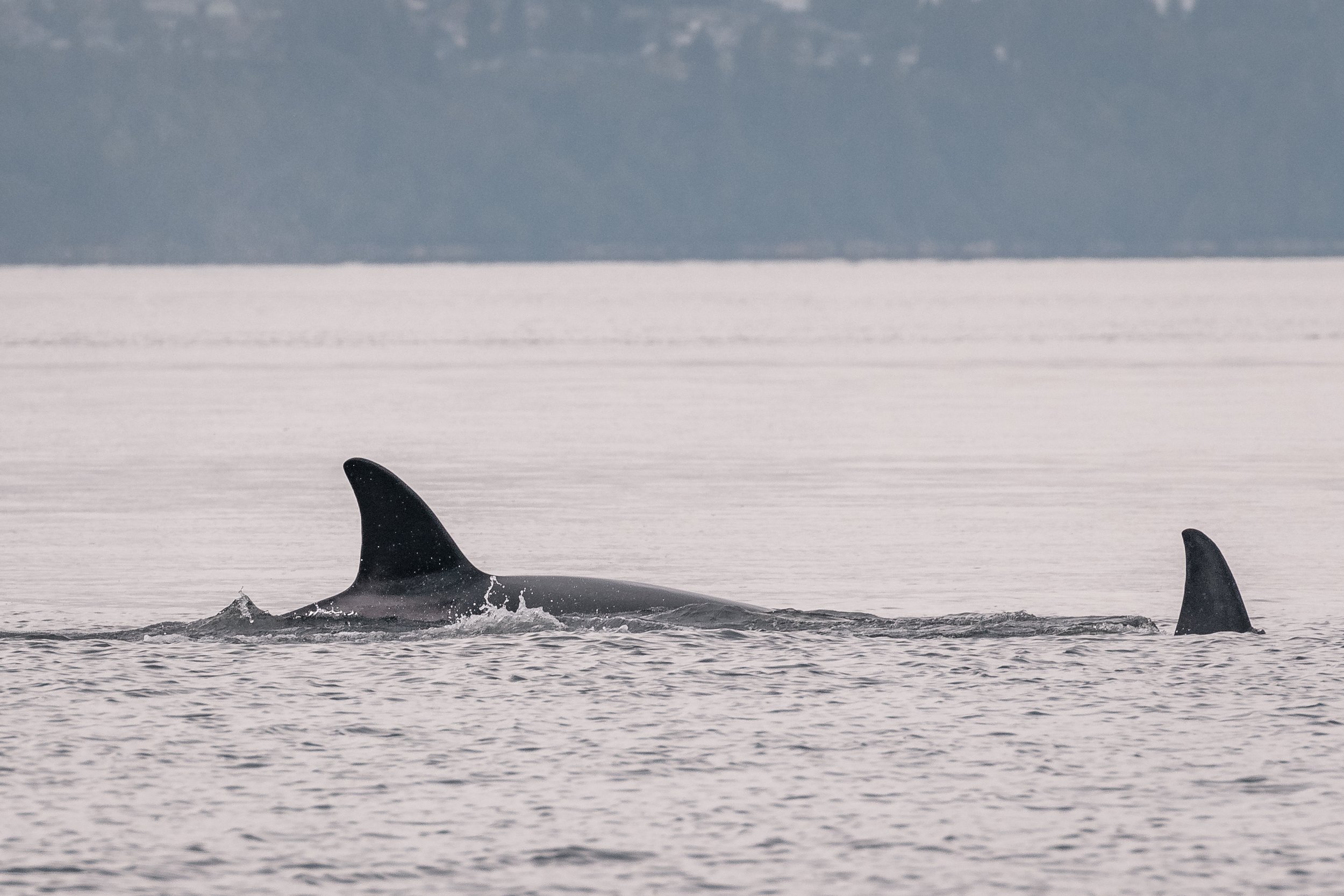May 31, 2022 - 3 pods of orca right outside Nanaimo's harbours
The water was glass as our tour pushed off the docks at 10:30, eager guests and an excited crew started scanning the waters for a shore report of orca right near Departure Bay. They were quick to find the T123’s, a family of 4 whales, travelling near Hudson Rocks. This family of whales is fairly well known, matriarch Sidney travels with her 3 kids. Her eldest son Stanley (T123A) is 22 years old this year. His impressive dorsal fin dwarfs his two younger sisters, T123C Lucky who is 10 this year, and T123D Darcy who turns 4.
That family seemed to be on a mission, as we travelled with them they began to pick up speed and head out into the Strait of Georgia. hey began doing some tail slapping and barrel rolling, playfully chasing each other and moving off towards the Sunshine Coast. At one point Stanley got tired of waiting for his family and decided to break off and lead the way across the Strait. At this point we heard of a second pod sighted nearby, so instead of following the T123’s across the Strait, we turned to look for the second group of whales. This report was of whales near Duke point, a report of 3 large males. When we found these whales they were travelling out to the Strait as well, heading in the same direction as the T123’s had. Seems there was some important orca meeting up north we weren’t aware of. We were quick to ID these whales, as they are also common and well known in our region. It was T063 and T065, Whidbey II and her son Chainsaw travelling with the T101’s, matriarch Reef and her 2 boys Rush and Lagoon.
These 5 whales were a little less playful but exciting to see nonetheless. The T101 boys are very large males with impressively straight dorsal fins that tower over their mother. With hardly a nick on their fins, it can be difficult to tell the brothers apart, and they often travel on top of one another, making it more difficult. Chainsaw is very easy to ID, with his large jagged fin slicing through the water. Whidbey II and Reef have very similar fins and are harder to tell apart, and they made it extra difficult today as they surfaced in sequence. Reef then Wind by then Reef again. Thanks to our naturalist being quick with the camera we were able to clearly ID both matriarchs on the water.
T123A Stanley. Photo by Cheyenne Brewster.
T123 Sidney. Photo by Cheyenne Brewster.
T123A Stanley. Photo by Cheyenne Brewster.
T123A Stanley. Photo by Cheyenne Brewster.
T123A Stanley. Photo by Cheyenne Brewster.
T123A Stanley. Photo by Cheyenne Brewster.
T123A Stanley showing off his massive pecs. Photo by Cheyenne Brewster.
Did you know whales have the same bone structure in their fins as we do in our hands? Looking at Stanley’s pectoral fins you can almost make out where his fingers would be if he had human hands!
T123A Stanley. Photo by Cheyenne Brewster.
T123A Stanley. Photo by Cheyenne Brewster.
T123A Stanley. Photo by Cheyenne Brewster.
T123’s. Photo by Cheyenne Brewster.
T123’s. Photo by Cheyenne Brewster.
T123 Sidney. Photo by Cheyenne Brewster.
T123A Stanley. Photo by Cheyenne Brewster.
T123’s. Photo by Cheyenne Brewster.
T123C Lucky and her mother T123 Sidney. Photo by Cheyenne Brewster.
T123A Stanley and his little sister T123C Lucky. Photo by Cheyenne Brewster.
T123A Stanley and his little sister T123C Lucky. Photo by Cheyenne Brewster.
T123C Lucky. Photo by Cheyenne Brewster.
T123A Stanley and T123D Darcy. Photo by Cheyenne Brewster.
T123’s. Photo by Cheyenne Brewster.
T123’s. Photo by Cheyenne Brewster.
T123D Darcy - she has new notches near the tip of her dorsal that give her a ‘scalloped’ edge - can you see them? Photo by Cheyenne Brewster.
T123 Sidney. Photo by Cheyenne Brewster.
T063 Chainsaw and T101A Rush. Photo by Cheyenne Brewster.
T065 Whidbey II and T101B Lagoon. Photo by Cheyenne Brewster.
T101B Lagoon. Photo by Cheyenne Brewster.
T063 Chainsaw and T101 Reef. Photo by Cheyenne Brewster.
T101B Lagoon. Photo by Cheyenne Brewster.
After our time with the whales near Nanaimo today we stopped by Entrance Island to take a look at some pinnipeds. The Steller sea lions were lounging on the rocks, enjoying the calm day, while the harbour seals did the same on a small rock off of Orlebar point on Gabriola Island.
All photos today were taken by marine naturalist Cheyenne Brewster.
Photo by Cheyenne Brewster.
Snoozing sea lions. Photo by Cheyenne Brewster.
Balancing act! Photo by Cheyenne Brewster.
Photo by Cheyenne Brewster.



































